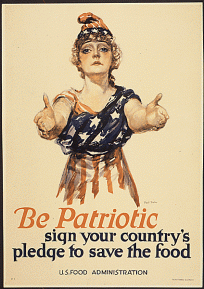After nearly three years of war, by 1917 Europe was facing starvation. Farms were transformed into battlefields or left un-planted as workers were forced into service. Transportation routes were disrupted, making access to food challenging to say the least.
On August 10, 1917, congress passed a controversial piece of legislation: “An Act to Provide Further for the National Security and Defense by Encouraging the Production, Conserving the Supply, and Controlling the Distribution of Food Products and Fuel.” It also banned the production of “distilled spirits” from any produce that was used for food. This Act created the Food Administration and the Fuel Administration; President Wilson appointed Herbert Hoover to head the Food Administration. This gave Mr. Hoover authority to fix food prices, license distributors, coordinate purchases, oversee exports, act against hoarding and profiteering, and encourage farmers to grow more crops.
World War I came to the United States in the midst of the Progressive Era – when efficiency and expertise were highly valued. This mindset provided a platform for the government to establish agencies to address issues of economy, society, and production for the war effort, and avenues to motivate people.
In January 1918, President Wilson issued a proclamation calling upon Americans to demonstrate their patriotism by following Hoover’s guidelines. Hoover did not want to impose rationing, so he pushed compassion and patriotism to encourage volunteerism for food programs.
Hoover introduced “Meatless Tuesdays”, “Wheatless Mondays”, and “Sweetless and Porkless Saturdays”. Local food boards offered guidance to comply with these programs by demonstrating how to prepare meals, alter recipes, and preserve food, such as canning. They also encouraged development of “Liberty Gardens” where people could grow their own food. Homeowners were urged to sign and publicly display pledge cards that testified to their efforts to conserve food. As a result of these efforts, food shipments doubled within a year, while consumption in the US was reduced by 15% between 1918 and 1919. This continued after the end of the war as an effort to feed millions of displaced people in Europe. Hoover earned the nickname “Great Humanitarian” for his efforts. (He insisted on no salary – arguing it would give him the moral authority he needed to ask Americans to sacrifice to support the war effort.)
To provide adequate nourishment to troops and allies, a series of posters were created to encourage reducing consumption on the home-front to secure food needed for troops – such as meat, wheat, fats and sugar. Slogans like “Food Will Win The War” and “Sow The Seeds of Victory” encouraged people to eat locally, reduce waste, and alter eating habits to allow for increased food shipments to soldiers.
All of these posters testify to the intent of the government to mobilize the food effort during World War I. As much as possible, it did so under a banner of volunteerism, rather than coercion. In doing so, the Wilson administration created a program that affected the everyday lives of Americans during World War I. These programs also paved the way for future home-economics!
Local Scott County Newspapers:
January 1917: “Would you help a starving child?.. Thousands of babies in war-torn Europe are starving this winter. The Children’s of America’s Fund is rushing aid as fast as possible. Ten cents will give a starving child a day’s life, three dollars a month’s life.”
“Government Fixes Wheat, Flour Prices. For the first time in U.S. history, the government has taken a hand in price-fixing of farm products and food products. The first items being regulated are wheat and flour. Since August, prices in local markets have been governed buy the National Food Control Board.”
“With cream $.46 pound, live hogs $14.80 per hundred weight, wheat $2.37 and beef on the hoof $.11/pound in local markets, it is apparent that the farmer is getting war-time prices for his products. One way to fight the high cost of living is to either plant a garden and take care of it or increase the garden you already have.”
April 1917: “There will be little or no waste land in Jordan this season. The high cost of every kind of food causes people to think. Every available bit of vegetable garden land will be put to use.”
“Meatless days are being observed by millions of Americans on Tuesdays, and Wednesdays are being observed as wheatless days, thereby helping conserve the food supply.”
May 1918: “Don’t forget to provide against possible sugar shortage by planting some sorghum. It can be planted until May 10. An experience farmer suggests breaking up a corner of pasture land and fencing it off, then planting the tract to sorghum.”
November 1918: “The world is hungry. America now plans on relieving the distress in Austria, Russia…in addition to what it had been doing before the Armistice. We must all co-operate to eliminate waste, to save our of our abundance in order that the needy of other lands may have food. Food won the war. Food will save humanity.”



